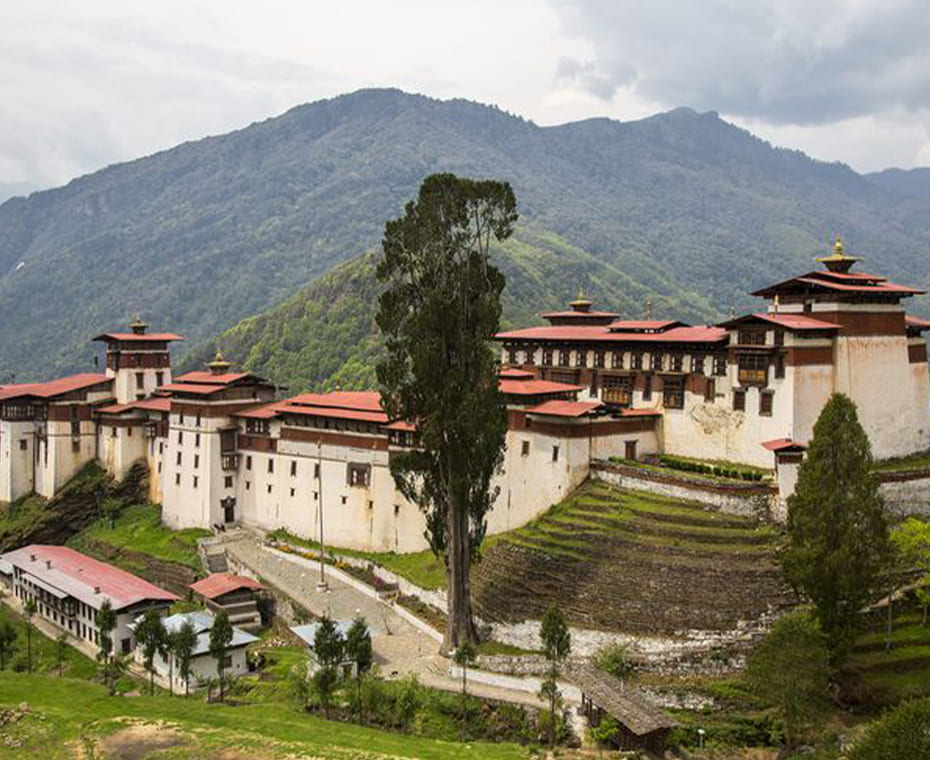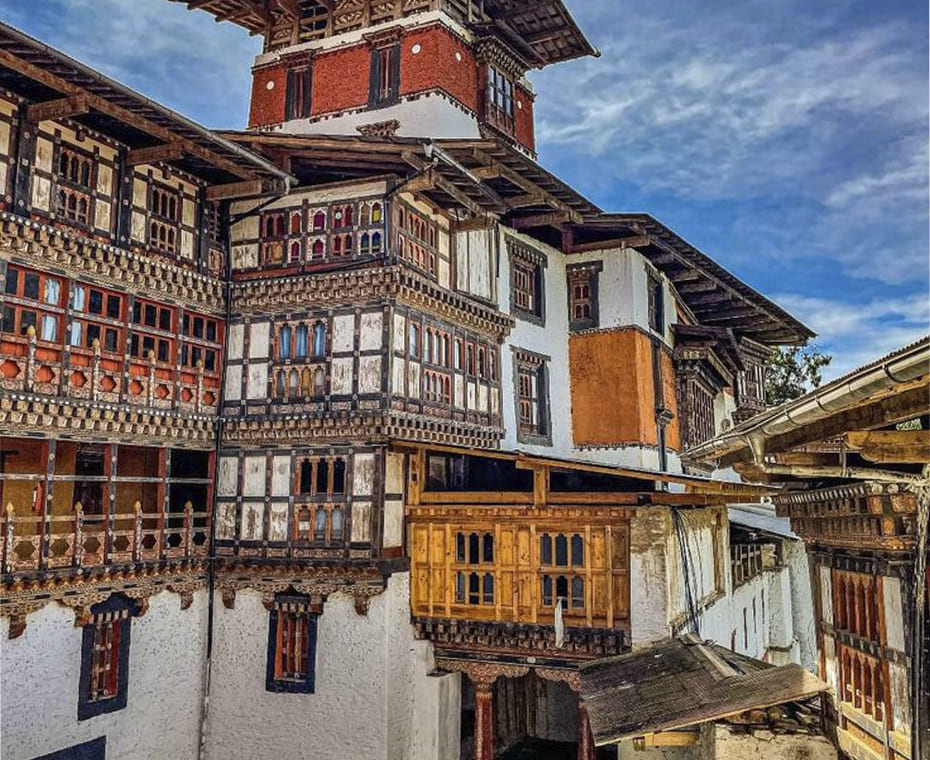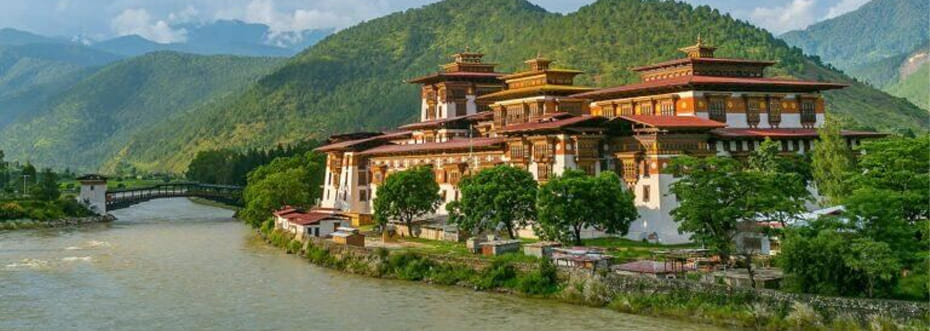




DAY 1 : Delhi / Paro (By flight) / Thimpu
Flight to PARO. The flight to Bhutan will take you to the Himalayas, offering glittering landscapes of the world's highest glacial peaks.
Arrival at PARO. Your guide will be waiting for you for the transfer to THIMPU, the capital of the country. The capital of BHUTAN is the administrative, religious and commercial center of the country. It is unique in its combination of ancestral traditions and the modernity of our time.
Free end of the afternoon.
Overnight at the hotel.
DAY 2 : THIMPHU
Breakfast at the hotel
Departure for the Visit to the Thimphu Valley:
The National Library, with its collection of precious Buddhist manuscripts; It was established in 1967 with the objective of “preserving and promoting the rich cultural and religious heritage” of Bhutan.
Continue towards Buddha Point (Kuensel Phodrang): Located a short distance from Thimphu city center, from here visitors can get a very good overview of the Thimphu Valley. You can pay your obedience and offer prayers to the Buddha, the largest statue in the country and then walk around and take a glimpse of the valley.
On the way back visit Takin Preserve - Takin is the national animal of Bhutan and resembles a cross between a cow and a goat. According to legend, the animal was created by the great Buddhist yogi, Drupa Kunley, and it can only be found in Bhutan and surrounding areas. Also visit Anim Dratshang (Nunnery) in Drubthob Goemba.
Visit the folklore museum, a pretty 300-year-old house which recreates traditional Bhutanese housing, then the very beautiful textile museum, one of the country's major crafts
Visit the King Chorten Memorial which was erected in memory of the third king, Jigme Dorji Wangchuck (1929 - 1972), considered the father of modern Bhutan.
The Queen Mother had it raised in tribute to her son who died suddenly in 1972 of a heart attack. At the entrance, huge prayer wheels are constantly operated by pilgrims. Each side of the entrance porch is decorated with three carved slates. Those on the outside represent the three bodhisattvas: of Compassion (Tchenrezig), of Knowledge (Manjusri) and of Power (Vajrapani).
Next, visit Trashichhoedzong, "fortress to the glory of religion". It is the center of government and religion, the site of the monarch's throne room and the seat of Jé Khenpo or chief's house. Built in 1641 by the political and religious unifier of Bhutan, Shabdrung Ngawang Namgyal, it was rebuilt in the 1960s in the traditional Bhutanese way, without nails and without architectural plans.
Evening stroll in the local market.
Overnight at the hotel
DAY 3 : THIMPHU / GANGTEY (150 km – 5h30)
Breakfast at the hotel.
Departure for GANGTEY via the Dochula high mountain pass (3,080m)
You first cross the Dochu La pass marked by numerous prayer flags and the Druk Wangyal, an impressive set of 108 chortens where you will discover an incredible panorama of the peaks of the eastern Himalayas.
You then meander through a dense pine forest and discover the vast glacial valley of Phobjika to the west of the “black mountains” where the famous black-necked cranes that migrate from the Tibetan plateau during the winter settle. This valley is one of the most beautiful places in Bhutan.
Arrival at GANGTEY and lunch at the hotel. Afternoon discovery of the village and valley of Gangtey Phobjikha.
Overnight at the hotel.
DAY 4 : GANGTEY
Breakfast at the hotel.
Departure for a very pleasant walk: the Gangtey Nature walk
From the small hill overlooking Gangtey Goemba you will pass through flowering meadows to the village of Semchubara and from here through beautiful forests and into the open valley.
After passing a chorten and Khewa Lhakhang, the trail ends at the local community school; This walk takes around 30 minutes to the start of town.
You can take a walk around the village of Gangtey and visit Gangtey Gompa, the largest Nyingmapa monastery in Bhutan, the oldest tradition of Tibetan Buddhism
Overnight at the hotel.
DAY 5 : GANGTEY / TRONGSA / BUMTHANG
Breakfast.
Departure by road towards Bumthang via Trongsa through Pelela pass (3,300 m), the traditional border between East and West. The pass is marked by a prayer flag and the land is covered with high-altitude dwarf bamboo. En route Stop at Chendbji Chorten, which was built in the 18th century by a Lama named Shida, it is Nepalese in style with painted four-pointed eyes of the cardinals.
Visit Trongsa Dzong, like almost all towns in the Kingdom, this Dzong architecture dominates the entire Trongsa skyline, eclipsing the surrounding buildings. Built in 1648, it was the seat of power over central and eastern Bhutan. Both the first and second kings ruled the country from this ancient seat.
Then drive to Bumthang, during the Yutong-la pass (3,400 m / 11,155 p). The road winds steeply towards the pass, 28 km from Trongsa, then descends through coniferous forest into a wide open cultivated valley known as the Chumey Valley.
Overnight at the hotel.
DAY 6 : BUMTHANG
Breakfast at the hotel.
The whole day dedicated to the visits as below
Jambay Lhakhang: This monastery was built in the 7th century by the Tibetan king, Songtsen Gampo. It is one of the 108 monasteries built by him to subdue evil spirits in the Himalayan region. Its current architectural appearance dates from the beginning of the 20th century.
Kurje Lhakhang: Located before Jambay Lhakhang, Kurje Lhakhang consists of three temples. The one on the right was built in 1652 on the face of the shelf where Guru meditated in the 8th century. The second temple is built on the site of a cave containing a rock with the imprint of the guru's body and is therefore considered the holiest. The third temple was built in the 1990s by Ashi Kesang, the queen mother. These three temples are surrounded by a wall of 108 chorten.
Tamshing Lhakhang: Located across the river from Kurje Lhakhang, this temple was founded in 1501 by Terton Pema Lingpa, the reincarnation of Guru Padsambhava. The monastery has very old religious paintings like 1,000 Buddhas and 21 taras (feminine form of Buddhistava). The temple was restored at the end of the 19th century.
Take a stroll around the village, visit the small craft store at the entrance to the town, and perhaps have refreshments at a local restaurant or visit the Red Panda Brewery. The Red Panda Brewery and Swiss Cheese Shop were started by a Swiss immigrant, Fritz Maurer, in the 1960s. It's a perfect way to end a day in Bumthang. Red Panda beer is a pale straw-colored Hefeweizen and is made in small volumes, with flavors of banana, clove and a hint of lemon. Perfect to enjoy with locally made cheese.
(Pay directly on site for beer/cheese, consult the guide before visiting. This place is private, the visit is subject to the owner's approval)
Overnight at the hotel.
DAY 7 : BUMTHANG / PUNAKHA
Return to Punakha passing through dense oak and rhododendron forests.
Arrival at PUNAKHA,
Visit Punakha Dzong or (Palace of Great Happiness), built at the junction of the rivers Phochu and Mochu in 1637 by Shabdrung Namgyal. This majestic dzong served as both the religious and administrative center of Bhutan in the past. It measures approximately 600 by 240 feet and has a span of six stories, with the golden dome of the tower. Inside are courtyards and religious statuary that allude to the depth of historical and spiritual tradition embodied here. Your guide will enlighten your understanding of this complex culture that is exotic to us, yet long established here.
Visit the Sangchhen Dorji Lhuendrup Lhakhang convent:
Perched on a ridge among pine trees and overlooking the valleys of Punakha and Wangduephodrang, glow the magnificent structures of Sangchhen Dorji Lhuendrup Lhakhang (Temple). The temple houses a 14-foot bronze main statue of Avalokiteshvara (Chenrigzig chagtong chentong).
The temple complex also houses a permanent higher education and meditation center for nuns where, apart from religious training, it provides training in life skills such as sewing, embroidery, statue making and painting thangka.
In the afternoon, hike through fields of chili peppers, cabbages to Khamsum Yuelley Namgyal Chorten, which was built to eliminate negative forces and promote peace, stability and harmony in a changing world. The Chorten dominates the upper Punakha valley with stunning views across Mo Chhu and towards the mountain peaks of Gasa and beyond. (Approximately 2 hours of round-trip walking)
The rest of the day can be spent exploring Punakha village located on the riverbank.
Overnight at the hotel.
DAY 8 : PUNAKHA / PARO (125 / 04 H)
Breakfast at the hotel.
Later in the day departure for an excursion to Chimi Lakhang through the rice fields and villages.
The Lhakhang Chimi, located on a hill in the center of the valley, is also known as the fertility temple. It is widely believed that couples who do not have children and want one, if they pray in this temple, come out blessed with the hope of having a child very soon. The trail leads through the rice fields of the small settlement of Pana, which means "land." A walk through the village near the temple will give you a rare insight into the daily life and lives of the villagers.
Departure towards Paro, descending from Dochu La through the spectacular valleys crossed by the Chhu Wang and Paro Chhu rivers.
En route visit Simtokha Dzong, another masterpiece of Bhutanese architecture which remains miraculously spared from fires and natural disasters, damaging the country's riches in turn. It is
Arrival and installation at the hotel.
Later in the day visit Ta Dzong, originally built as a Watchtower, which now houses the National Museum. The extensive collection includes ancient Thangkha paintings, textiles, weapons and armor, household items and a rich assortment of natural and historical objects.
Overnight at the hotel.
DAY 9 : PARO
Breakfast at the hotel.
Excursion to the Taktsang Monastery (Alt: 3100m – 05 Hrs): one of the most famous monasteries in Bhutan, located on the side of a cliff (900m above the bottom of the Paro valley). It is said that Guru Rinpoche arrived here on the back of a tigress and meditated at this monastery. This site was recognized as a sacred place and was one of the most visited places by Shabdrung Ngawang Namgyal in 1646 (founder of Bhutan). Nowadays, every Bhutanese goes there at least once in their life.
Along the way, visit the 7th-century Kyichu Lhakhang, one of 108 temples built in the Himalayas by the Tibetan king Songtsen Gampo. The construction of this temple marks the introduction of Buddhism to Bhutan.
In the evening walk around town and visit the market.
Overnight at the hotel.
DAY 10 : PARO / DELHI (BY FLIGHT)
Breakfast.
Transfer to the airport. Assistance with baggage check-in and boarding. Flight to Delhi.